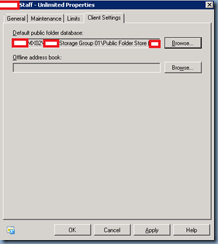Problem
You’ve completed migrating all of your users’ mailboxes from Exchange 2003 to 2010 and used the PowerShell scripts to configure replicas of the legacy Exchange server to your new Exchange 2010 server. The replicas were moved after you’ve verified that all of the folders were replicated over but as soon as you shut down your Exchange 2003 services, your users are no longer able to expand the Public Folder tree. The error message in Outlook reads:
Cannot expand the folder. Microsoft Exchange is not available. Either there are network problems or the Exchange computer is down for maintenance. (/o=Contoso/ou=First Administrative Group/cn=Configuration/cn=Servers/cn=exchange2k3Server)
Solution
Note that this issue can be caused by many reasons and while troubleshooting this a few months back, I checked everything aside from the simplest setting which is why I’m writing this post.
One of the first setting to check is the Default public folder database setting for your Exchange 2010 information store so open the Exchange Management Console –> Microsoft Exchange –> Organization Configuration –> Mailbox then right click on your store and select properties:
Navigate to the Client Settings tab and make sure your Default public folder database is set to your new Exchange 2010 server:
Once you have this setting configured appropriately, you’ll need to wait till the settings have replicated across your domain controllers and once they have, you should now be able to browse the public folders.








7 Responses
Thanks. This was exactly my problem. However I migrated from 2007 to 2010 exchange 🙂
I also migrated from Exchange 2007 to 2010 and found this an issue for me as well. Steps above fixed the problem for me.
I cannot see the client settings tab on the properties of the PF database. I see only General, Replication, Limits and Public Folder Referrals
Sorry, I was looking at the properties of the Public folder DB. These tabs are on the properties of the mailbox DBs. I'm OK now.
Worked perfect.
Thank you so much
Thanks! This was the exact issue I ran into with a migration from 2003 to 2007. Thanks again!
Thank you ! Your Post really helped!
Migrated from 2007 to 2010 and had the same problem. Spent days searching for the cause and your solution took 5 minutes, where none of the migration documentation even mentions it. Thank you!